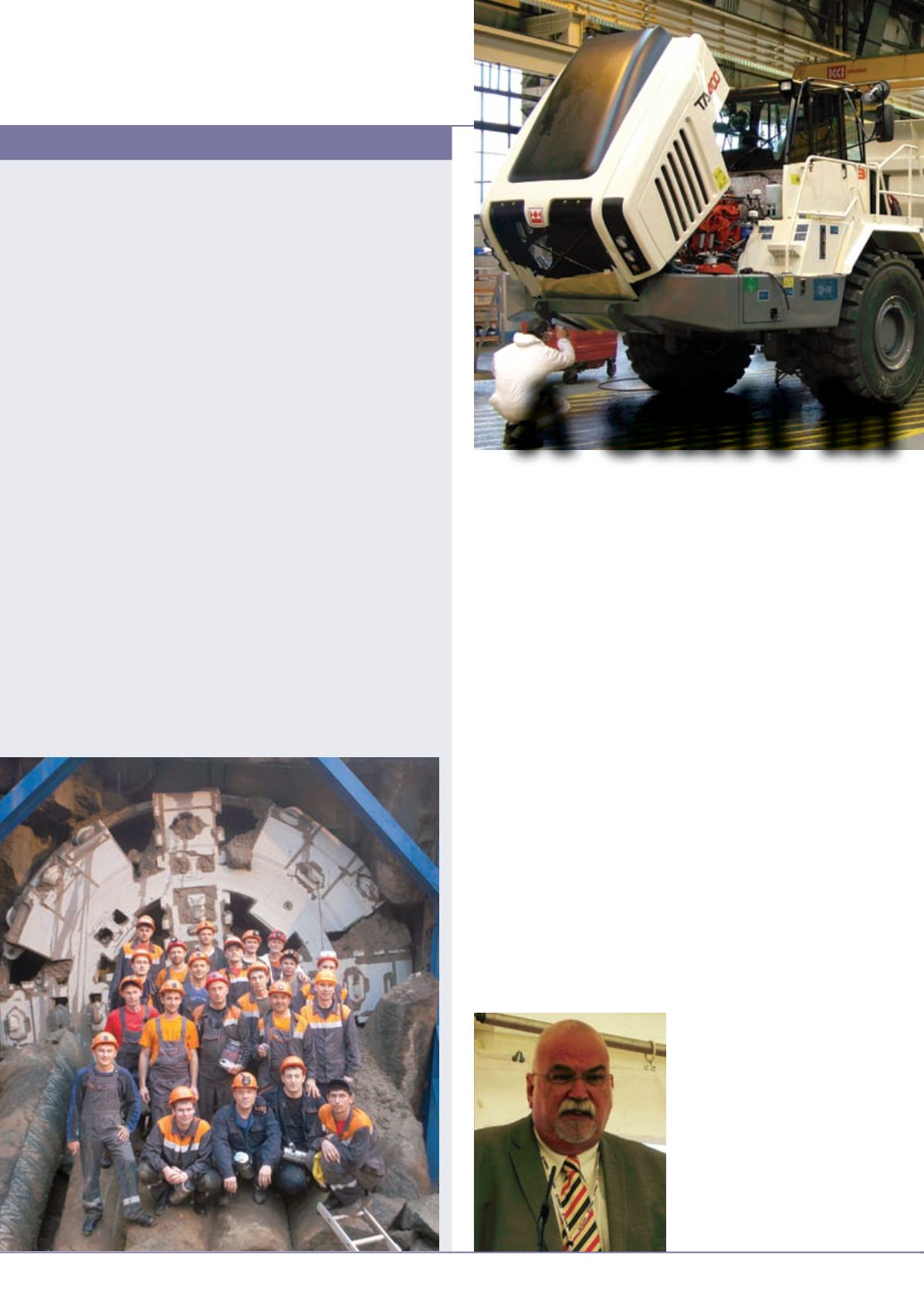
EQUIPMENT
60
international
construction
july-august 2013
Terex is pushing more and more into emerging
markets with both its articulated and rigid frame
haulers.
Helen Wright
reports.
T
erex’s 28,000 m
2
off-highway
truck factory in Motherwell,
UK, has seen a US$ 5
million investment in production
line equipment for both its rigid
and articulated dump trucks (RDTs
and ADTs).
Production is poised to increase
in-line with new opportunities.
While the factory can produce up
to six ADTs and two RDTs per day
running at maximum capacity, its
current production target is 400
ADTs and RTDs combined for
2013.
Demand in the mature markets
of North America and Europe may
have softened in recent years, but
sales of both ADTs and RDTs are
increasing in emerging markets, and
Terex is eyeing these opportunities.
John Mlonek, commercial sales
manager at Terex Construction,
said, “We have seen a dramatic
change in recent years – the whole
emphasis has shifted towards
emerging markets.”
Mr Mlonek said the company
was considering opportunities in
the world’s growth markets, and
wouldn’t rule out further joint
ventures. Terex has experience in
this field – last year, it established
a joint venture with Russian
Machines to manufacture
construction and road building
equipment in Russia, and also set
up a joint venture partnership in
China with Sinomach to produce
truck cranes.
“With the mineral wealth of
Africa, Russia and Asia, we have to
think of our options,” Mr Mlonek
said. “It may be in the future that
we will look at joint ventures in
Africa and elsewhere – we are
considering our options.”
The largest ADT model Terex
manufactures is the 40 tonne class
TA400 – part of its Generation
9 range that also includes the
30-tonne class TA300 and
25-tonne class TA250. Terex also
manufactures five RDTs, from 32
tonnes to 91 tonnes payload.
A shift in
John Mlonek, commercial sales
manager at Terex Construction:
“We have seen a dramatic change
in recent years – the whole
emphasis has shifted towards
emerging markets.”
RUSSIA
Metro breakthrough
The first of three Robbins earth pressure balance (EPB) tunnel boring machines
(TBMs) excavating the Moscow Metro has made its breakthrough. As well as
finishing the bore early in late May, the project saw a new Russian record set
by the 6.2 m diameter machine, with an advance of 37.8 m being achieved in a
single day in April 2013 – the greatest ever achieved for a machine in this class
in the country.
Launched in the winter of 2012, the TBM achieved advance rates of 150 m
per week. “The soil condition, crew experience, rigorous schedule, continuous
conveyor, and the reliability of the Robbins TBM are all factors that helped
achieve the record,” said Vadim Bocharov of contractor SK MOST.
The machine will now be disassembled in the receiving station site and
launched on an additional 1.4 km tunnel in the last quarter of 2013. It is one of
several Robbins EPBs on the massive metro project where dozens of TBMs are
operating simultaneously. Two 6.6 m diameter Robbins EPBs are excavating
left and right-hand tunnels, each 2.0 km in length, for contractor Engeocom. A
third machine refurbished by Robbins for Engeocom, nicknamed “Julia”, is also
excavating a 2 km section of tunnel.
Ground conditions in the city are said to be challenging, consisting of fine sand,
gravel, loam, stiff clays and boulders. The EPBs are designed for the conditions,
with active articulation to enable excavation of tighter curves without the risk of
tunnel segments deforming. Two-component back-filling is being used to reduce
the risk of settlement at the densely urban tunnel sites. Mixed ground cutterheads
reinforced with abrasion-resistant wear plate give the option of changing the
carbide knife-edge bits with 17-in (432 mm) disc cutters, depending on the
conditions.
Moscow’s Metro Development Program, unveiled in 2012 by the Moscow
Government, calls for 150 km of new metro lines to be build in the next eight
years. Work thus far has been around the clock, with close to 18,000 workers
and specialists engaged in the projects. Their number is expected to reach
35,000 by the end of 2013.
Terex
■
Robbins
HIGHLIGHT


